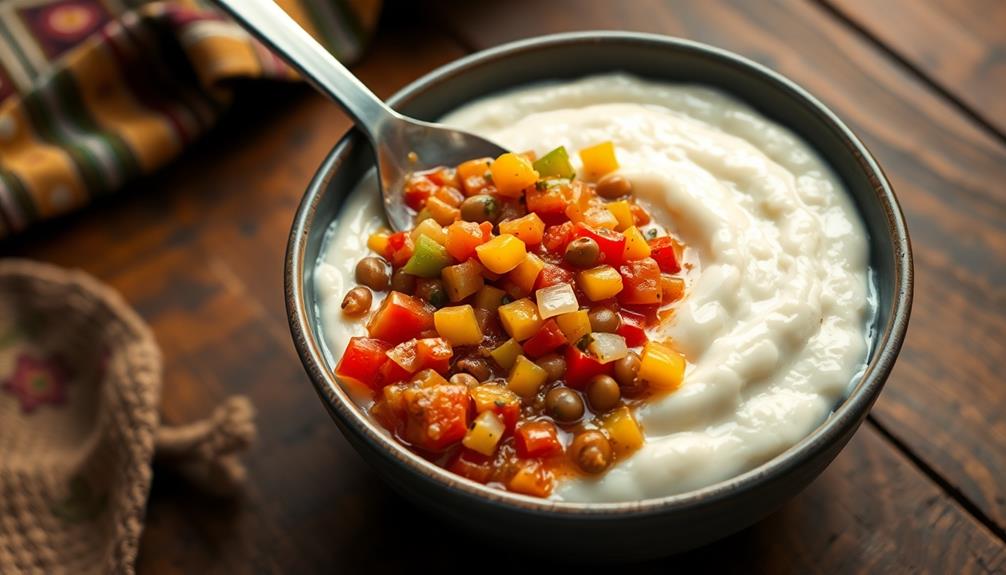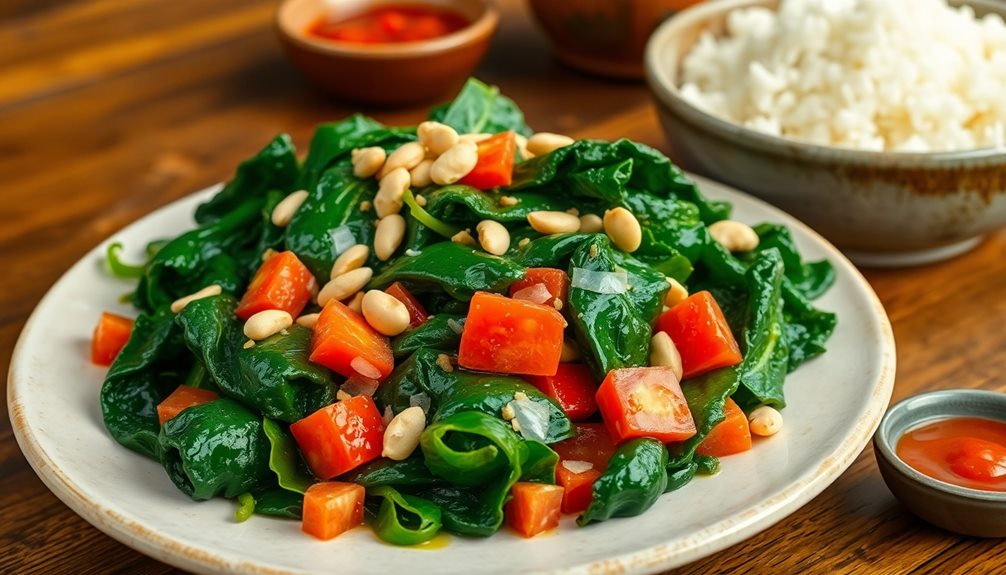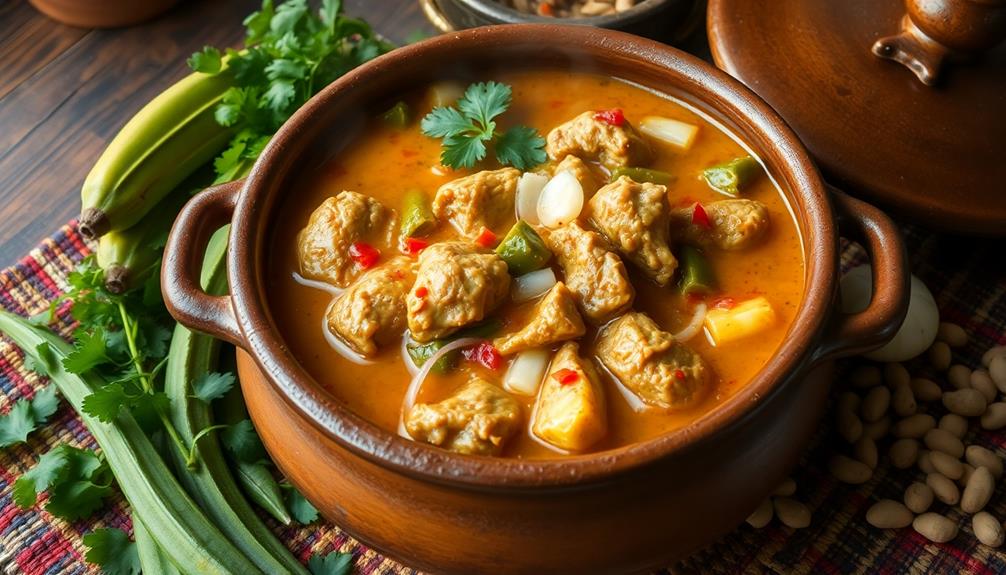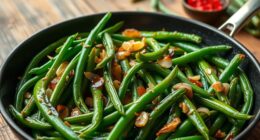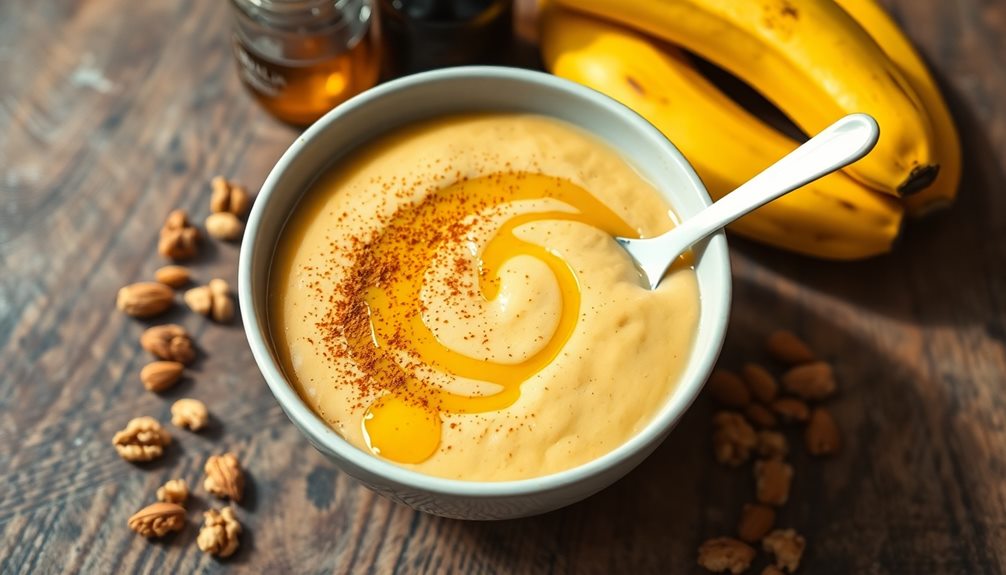Discover the delicious world of South African cuisine with pap and chakalaka! Pap, a creamy cornmeal porridge, forms the perfect base for the vibrant and spicy chakalaka. This colorful vegetable relish bursts with flavors of tomatoes, peppers, and aromatic spices. Together, they create a mouthwatering combination that's both comforting and exciting. You'll love how the smooth pap balances the zesty chakalaka, making every bite a tasty adventure. It's a versatile dish that's great for family dinners or festive gatherings. Whether you're new to African food or a seasoned fan, pap and chakalaka will make your taste buds dance with joy. Get ready to explore this delightful culinary duo!
History
Two distinct culinary traditions converged to create the popular South African dish of pap and chakalaka.
You'll find that pap, a staple food made from cornmeal, has been a part of African cuisine for centuries. It's like a thick porridge that'll stick to your ribs and keep you full for hours.
Chakalaka, on the other hand, is a relatively new addition to the South African table. In the early 20th century, workers in the gold mines of Johannesburg needed hearty, affordable meals. They'd often mix whatever vegetables they could find with beans and spices, creating a flavorful relish. This concoction became known as chakalaka.
It's a burst of color and taste that'll make your taste buds dance! As time went on, people started pairing the comforting pap with the zesty chakalaka. The combination was a hit!
You'd see it at family gatherings, community events, and even in restaurants. Today, pap and chakalaka is a beloved dish that represents the diverse culinary heritage of South Africa.
It's a tasty reminder of how different cultures can come together to create something truly special.
Recipe
Pap and Chakalaka is a beloved South African dish that combines two staple components: pap, a thick porridge made from maize meal, and chakalaka, a spicy vegetable relish. This hearty and flavorful combination is often served as a side dish but can also be enjoyed as a main course.
The beauty of this dish lies in its simplicity and versatility. While the basic ingredients remain consistent, many variations exist, allowing cooks to adjust the flavors and spiciness to their liking. The pap provides a neutral base that perfectly complements the bold and zesty chakalaka, creating a satisfying balance of textures and tastes.
Ingredients:
- 2 cups white maize meal
- 4 cups water
- 1 tsp salt
- 2 tbsp vegetable oil
- 1 onion, finely chopped
- 2 cloves garlic, minced
- 1 green bell pepper, diced
- 2 carrots, grated
- 1 can baked beans
- 2 tomatoes, chopped
- 2 tbsp tomato paste
- 1 tsp curry powder
- 1 tsp paprika
- Salt and pepper to taste
- Optional: 1 chili pepper, finely chopped
To prepare the dish, start by making the pap. Bring the water to a boil in a large pot, then slowly add the maize meal while stirring constantly to prevent lumps. Reduce heat and simmer for about 30 minutes, stirring occasionally until the pap is thick and smooth.
For the chakalaka, heat oil in a pan and sauté the onion and garlic until softened. Add the bell pepper, carrots, and chili (if using) and cook for a few minutes. Stir in the remaining ingredients and simmer for 15-20 minutes until the vegetables are tender and the flavors have melded.
Serve the pap hot with the chakalaka spooned over the top.
For the best results, use a wooden spoon or a whisk to stir the pap, as this helps achieve a smoother consistency. The chakalaka can be made in advance and reheated, allowing the flavors to develop further.
Feel free to adjust the spiciness by adding more or less chili, or experiment with different vegetables to create your own unique version of this classic South African dish.
Cooking Steps
You're ready to cook up a storm with pap and chakalaka!
First, you'll start by boiling water and adding cornmeal for the pap, stirring constantly until it reaches a thick, creamy consistency.
While the pap simmers, you'll cook up a colorful mix of vegetables for the chakalaka, creating a perfect side dish to serve alongside some tasty grilled meat.
Step 1. Boil Water in Pot
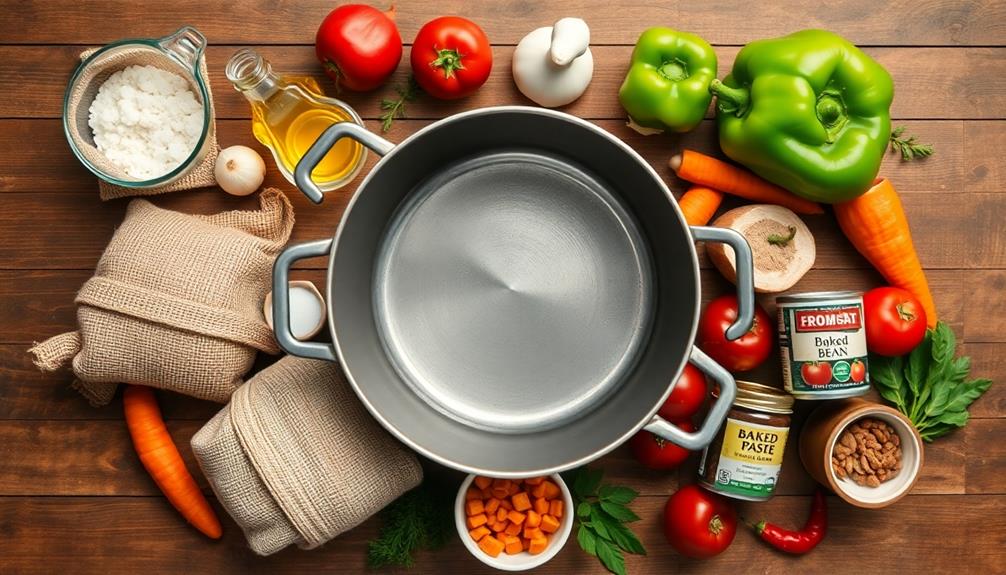
The pot takes center stage as you begin the cooking process. It's time to get that water boiling! Grab your favorite large pot and place it on the stove. You'll want to use a pot that's big enough to hold all the pap you're planning to make.
Now, turn on the burner and set it to high heat.
Next, you'll need to add the water. Measure out the right amount, which is usually about twice as much water as the amount of maize meal you'll be using. Pour the cool, clear liquid into the pot and watch as it starts to warm up. You might see tiny bubbles forming at the bottom of the pot as the temperature rises.
Keep a close eye on your pot as the water heats up. Soon, you'll notice larger bubbles rising to the surface and steam starting to appear.
When the water is at a rolling boil, with lots of big bubbles and steam, you're ready for the next step in making your delicious pap!
Step 2. Add Cornmeal, Stir Constantly

With the water at a rolling boil, it's time to add the cornmeal. You'll want to sprinkle it in slowly, a little at a time. As you add the cornmeal, use your wooden spoon to stir constantly. This helps prevent lumps from forming and guarantees a smooth texture.
Keep stirring as you gradually pour in more cornmeal. You'll notice the mixture starting to thicken. It might look a bit like liquid cement at first, but don't worry! That's exactly what you want. The cornmeal will absorb the water and turn into a thick, creamy paste.
As you stir, you'll feel the mixture getting harder to move. Your arm might get a little tired, but keep going! This constant stirring is key to creating the perfect pap.
You'll know you're done when the pap pulls away from the sides of the pot and forms a ball-like shape. The smell of cooked cornmeal will fill your kitchen, warm and comforting. Your pap is almost ready to be paired with the flavorful chakalaka!
Step 3. Simmer Until Thick Consistency
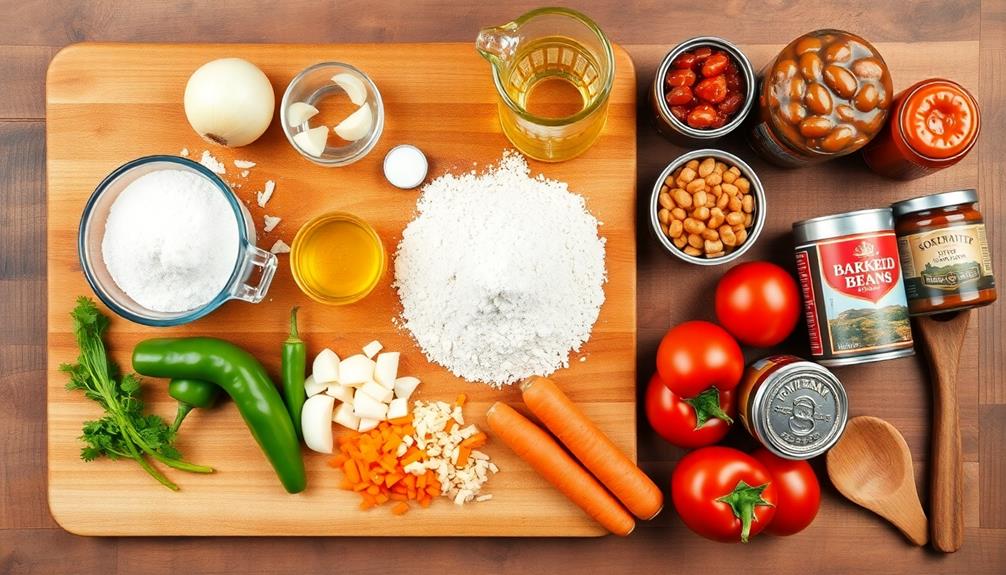
Once you've achieved that ball-like shape, it's time to let the pap simmer. Turn the heat down to low and cover the pot with a tight-fitting lid.
You'll want to let it cook for about 30 minutes, stirring occasionally to prevent sticking. As it simmers, you'll notice the pap getting thicker and smoother.
Keep an eye on your pap as it cooks. Every 10 minutes or so, give it a good stir with a wooden spoon. You'll feel the resistance as you mix, which is a sign that it's thickening nicely.
If it seems too dry, you can add a splash of hot water and mix it in well.
The pap is ready when it has a thick, creamy consistency that holds its shape when you scoop it. It should look smooth and glossy, with no lumps in sight.
When you lift your spoon, the pap should slowly slide off, leaving a thick coating behind. This perfect texture is what makes pap so delicious and satisfying.
Once you've reached this stage, your pap is ready to serve alongside your flavorful chakalaka!
Step 4. Cook Vegetables for Chakalaka
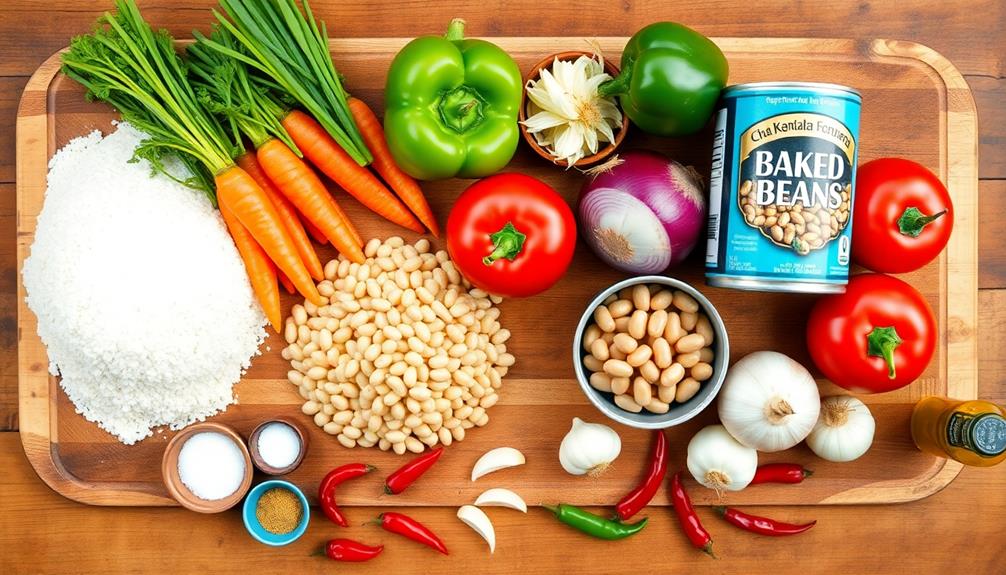
Now that your pap is simmering, let's turn our attention to the chakalaka. You'll love how colorful and flavorful this veggie-packed side dish is!
Start by heating some oil in a large pan over medium heat. Chop up a big onion and toss it in, letting it sizzle and turn golden brown. Can you smell that amazing aroma?
Next, it's time to add the rainbow of veggies. Dice up some bell peppers – red, green, and yellow if you'd like – and throw them in with the onions. Stir in some grated carrots and minced garlic, too. Watch as the veggies start to soften and their colors become even brighter.
Now, add some chopped tomatoes and let them cook down until they're nice and saucy. For extra flavor and a bit of kick, sprinkle in some curry powder, paprika, and chili flakes if you like it spicy. Don't forget to season with salt and pepper to taste.
Keep stirring and let everything cook together until the vegetables are tender and the flavors have melded beautifully.
Step 5. Serve With Grilled Meat

Your chakalaka is simmering nicely, filling the kitchen with its enticing aroma. Now it's time to prepare the perfect accompaniment: grilled meat! Fire up your grill or heat a grill pan on the stove. Choose your favorite cuts of meat, like juicy chicken thighs, tender lamb chops, or flavorful beef steaks. Season them with salt, pepper, and your favorite spices.
While the meat cooks, set the table with colorful plates and utensils. The sizzling sounds and smoky scents will make everyone's mouths water.
Once the meat is done, with beautiful grill marks and a tempting fragrance, it's time to serve. Place a generous portion of pap on each plate, creating a soft bed for the chakalaka. Spoon the vibrant chakalaka next to the pap, letting its rich colors shine. Finally, add the grilled meat to complete this delicious South African feast.
Encourage everyone to mix the flavors together on their plates. The creamy pap, spicy chakalaka, and savory grilled meat create a perfect harmony of tastes and textures. Enjoy this comforting meal with family and friends, savoring each delightful bite!
Final Thoughts
Reflecting on the delightful pairing of pap and chakalaka, it's clear why this combination has become a beloved staple in South African cuisine.
The creamy, comforting texture of pap perfectly complements the zesty, colorful chakalaka, creating a harmony of flavors that dance on your taste buds. It's a match made in culinary heaven!
As you've learned, this dynamic duo isn't just delicious, it's also versatile.
You can enjoy it as a main dish, a side, or even as part of a larger feast. The best part? You can easily adjust the spiciness of the chakalaka to suit your preferences, making it a crowd-pleaser for all palates.
Frequently Asked Questions
Is Pap and Chakalaka Suitable for Vegetarians or Vegans?
You'll find pap is suitable for both vegetarians and vegans as it's made from cornmeal. Chakalaka can be vegetarian-friendly, but you'll need to check if it contains animal products like anchovies or meat stock.
Can Pap and Chakalaka Be Frozen for Later Consumption?
You can freeze both pap and chakalaka for later use. They'll keep well in the freezer for up to 3 months. Just make sure to store them in airtight containers and thaw completely before reheating.
What Are Some Common Side Dishes Served With Pap and Chakalaka?
You'll often find grilled meats, like boerewors or braai, served alongside pap and chakalaka. Other common sides include samp and beans, umngqusho (crushed corn), steamed vegetables, or a fresh green salad. Don't forget to try some pickled vegetables too!
Are There Regional Variations of Pap and Chakalaka Across South Africa?
You'll find regional variations across South Africa. Different areas add their own twist to pap's texture and flavor. Chakalaka recipes vary too, with some regions using more spices or adding unique local ingredients to the mix.
What Wine or Beverage Pairs Well With Pap and Chakalaka?
You'll find that a fruity Pinotage or Chenin Blanc pairs wonderfully with this dish. If you're not into wine, try a cold lager or a rooibos iced tea for a revitalizing contrast to the spicy flavors.
